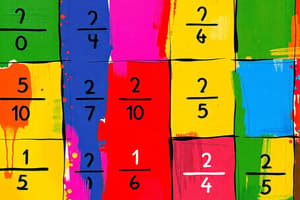Podcast
Questions and Answers
What is the reciprocal of the fraction $\frac{5}{8}$?
What is the reciprocal of the fraction $\frac{5}{8}$?
- $\frac{1}{5}$
- $\frac{-5}{8}$
- $\frac{5}{8}$
- $\frac{8}{5}$ (correct)
Dividing a fraction by another fraction is the same as multiplying the first fraction by the reciprocal of the second fraction.
Dividing a fraction by another fraction is the same as multiplying the first fraction by the reciprocal of the second fraction.
True (A)
What is the result of$\frac{3}{4} \div \frac{2}{3}$? Simplify your answer.
What is the result of$\frac{3}{4} \div \frac{2}{3}$? Simplify your answer.
9/8
To divide a fraction by a whole number, rewrite the whole number as a fraction with a denominator of ______, then multiply by the reciprocal.
To divide a fraction by a whole number, rewrite the whole number as a fraction with a denominator of ______, then multiply by the reciprocal.
What is the simplified form of $\frac{6}{8}$?
What is the simplified form of $\frac{6}{8}$?
The reciprocal of 7 is $\frac{1}{7}$.
The reciprocal of 7 is $\frac{1}{7}$.
Which operation is equivalent to $\frac{5}{6} \div 4$?
Which operation is equivalent to $\frac{5}{6} \div 4$?
Solve the following: $ 5 \div \frac{2}{7}$
Solve the following: $ 5 \div \frac{2}{7}$
A baker has $\frac{2}{3}$ of a bag of flour and uses $\frac{1}{4}$ of the bag for each cake. How many cakes can the baker make?
A baker has $\frac{2}{3}$ of a bag of flour and uses $\frac{1}{4}$ of the bag for each cake. How many cakes can the baker make?
Match the division problem with its solution:
Match the division problem with its solution:
Flashcards
What is a reciprocal?
What is a reciprocal?
Flipping the numerator and denominator of a fraction.
Whole number as a fraction
Whole number as a fraction
Any whole number expressed as a fraction with a denominator of 1, e.g., 5 = 5/1.
Fraction ÷ Whole Number
Fraction ÷ Whole Number
Rewrite the whole number as a fraction (/1), then multiply by the reciprocal of that fraction.
Whole Number ÷ Fraction
Whole Number ÷ Fraction
Signup and view all the flashcards
Fraction ÷ Fraction
Fraction ÷ Fraction
Signup and view all the flashcards
Steps to Divide Fractions
Steps to Divide Fractions
Signup and view all the flashcards
Simplifying Fractions
Simplifying Fractions
Signup and view all the flashcards
Visual Models
Visual Models
Signup and view all the flashcards
Division Keywords
Division Keywords
Signup and view all the flashcards
Pizza Problem
Pizza Problem
Signup and view all the flashcards
Study Notes
- Dividing fractions involves understanding the concept of reciprocals and how they relate to division
- Dividing by a fraction is the same as multiplying by its reciprocal
Reciprocal of a Fraction
- The reciprocal of a fraction is obtained by swapping the numerator and the denominator
- For example, the reciprocal of 2/3 is 3/2
- When you multiply a fraction by its reciprocal, the result is always 1
- Example: (2/3) * (3/2) = 6/6 = 1
- Whole numbers can be written as a fraction by placing it over 1
- For example, the whole number 5 can be written as 5/1
- The reciprocal of a whole number, such as 5 (or 5/1), is 1/5
Dividing a Fraction by a Whole Number
- To divide a fraction by a whole number, you can rewrite the whole number as a fraction with a denominator of 1
- Then, multiply the fraction by the reciprocal of the whole number
- Example: (1/2) ÷ 3 = (1/2) ÷ (3/1) = (1/2) * (1/3) = 1/6
Dividing a Whole Number by a Fraction
- To divide a whole number by a fraction, rewrite the whole number as a fraction with a denominator of 1
- Multiply the whole number fraction by the reciprocal of the dividing fraction
- Example: 4 ÷ (2/5) = (4/1) ÷ (2/5) = (4/1) * (5/2) = 20/2 = 10
Dividing a Fraction by a Fraction
- To divide a fraction by another fraction, multiply the first fraction by the reciprocal of the second fraction
- Example: (1/2) ÷ (3/4) = (1/2) * (4/3) = 4/6 = 2/3
- Simplify the resulting fraction to its lowest terms if possible
Steps for Dividing Fractions
- Identify the fraction that you are dividing by (the second fraction in the division problem)
- Find the reciprocal of that fraction by swapping the numerator and the denominator
- Change the division sign to a multiplication sign
- Multiply the first fraction by the reciprocal of the second fraction
- Simplify the resulting fraction, if possible, by reducing it to its lowest terms
Simplifying Fractions
- Simplifying a fraction means reducing it to its lowest terms
- This involves dividing both the numerator and the denominator by their greatest common factor (GCF)
- For example, the fraction 4/6 can be simplified to 2/3 by dividing both 4 and 6 by their GCF, which is 2
Visual Models for Dividing Fractions
- Visual models, such as area models or number lines, can be used to illustrate the division of fractions
- These models can help to understand the concept of dividing fractions, especially when dealing with word problems
Word Problems Involving Division of Fractions
- Word problems often require understanding the context to determine whether to divide fractions
- Look for keywords or phrases such as "how many groups," "divided equally," or "shared among"
- Set up the division problem correctly based on the context of the word problem
- Solve the division problem using the steps outlined above, including finding the reciprocal and multiplying
- Make sure the answer is realistic and makes sense in the context of the word problem
Examples
- Problem: Sarah has 1/2 of a pizza left. She wants to share it equally between 3 friends. How much of the pizza does each friend get?
- Solution: (1/2) ÷ 3 = (1/2) ÷ (3/1) = (1/2) * (1/3) = 1/6. Each friend gets 1/6 of the pizza
- Problem: How many 1/4 cup servings are in 3 cups of ice cream?
- Solution: 3 ÷ (1/4) = (3/1) ÷ (1/4) = (3/1) * (4/1) = 12/1 = 12. There are 12 servings
Studying That Suits You
Use AI to generate personalized quizzes and flashcards to suit your learning preferences.




